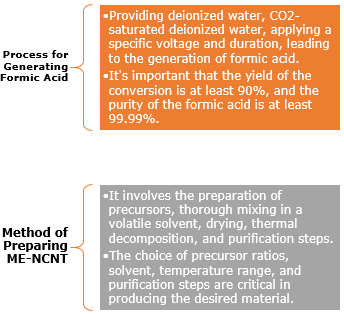Industrial Consultancy & Sponsored Research (IC&SR) , IIT Madras
Fe/Fe3C Encapsulated N-CNT Electrode for Electrochemical Applications and Method of Preparation thereof
Technology Category/ Market
Categories: Chemistry & Chemical Analysis | Energy, Energy Storage & Renewable Energy
Industry: Electrocatalysts, Renewable Energy, Green Technologies, Fertilizers, Pharmaceuticals, Biomedical, Electrochemical Energy Conversion
Applications: CO2 Conversion, Electrocatalysts, Renewable Energy, as chemical feedstock, in hydrogen storage & fuel cells
Market: The global Carbon Nanotubes (CNT) market was valued at $15.3 billion in 2017, and is projected to reach $103.2 billion by 2030, growing at 16.3% CAGR from 2021 to 2030.
Image Gallery
Problem Statement
- Formic acid is an important intermediate obtained during chemical reactions. Traditional formic acid production methods are energy-intensive, release harmful emissions, causing environment degradation and climate change.
- Noble metal catalysts, like platinum, used in electrochemical cells are expensive, cost-effective and limit large scale formic acid production.
- Current electrochemical cells may not operate at the optimal potential for maximum CO2 conversion to formic acid, leading to sub-optimal efficiency.
- Lack of collaborative platform & optimized catalysts hinders progress in the field, preventing efficient formic acid production.
- Addressing these issues is crucial to meet the increasing demand for formic acid in various industries while reducing the environmental footprint and advancing sustainable solutions.
- Hence, there is a demand of a new method to address the above mentioned issues.
Technology
The instant invention focuses on a novel electrode material and its synthesis, as well as its application in a polymer electrolyte membrane (PEM) assembly. The electrode material is made up of transition metal-enriched nitrogen-doped carbon nanotubes (ME-NCNTs).
- The technology introduces a ME-NCNT Electrode Material, consisting Fe3C nanoparticles, enclosed within 3-6 wt.% nitrogenated carbon nanotubes.
- The electrode material ME-NCNT can be loaded onto either the cathode or the anode surfaces at a specific loading density of 0.1 to 2 mg/cm2. Anode can be a Pt anode (platinum) or a CNT anode.
- In addition to Fe3C, the material may include one or more transition metals like Co, Ni, Ru, Os, & Eu. These may substitute Fe within Fe3C particles.
- The material should produce an X-ray diffraction pattern with characteristic peaks at specific angles, that correspond to the presence of Fe/Fe3C encapsulated within NCNT.
- The technology presents a Polymer Electrolyte Membrane (PEM) electrochemical conversion cell with Pt or CNT anodes and multiple Membrane Electrode Assemblies (MEA), each having a membrane layer between a cathode and an anode, along with vital components like an anolyte and catholyte flow channels for efficient cell operation.

Key Features / Value Proposition
Industrial Perspective:
- Reduces cost in electrochemical cells, aligns with renewable energy & carbon capture initiatives.
- Benefits multiple industries with very stable 3D structure ME-NCNT electrode material, enabling a high rate of CO2 to formic acid conversion (97%).
- The PEM cell incorporates a membrane electrode assembly, with ME-NCNTs loaded at a range of 0.1 to 2 mg/cm2, either as anode or cathode or both.
- PEM cell uses an anolyte & catholyte containing CO2. The CO2 present in the catholyte is subjected to a reduction process to produce formic acid.
User Perspective:
- Enables eco-friendly, formic acid production with stated purity of 99.99% with minimal emissions.
- It is Useful in energy storage & fuel generation. It optimizes electro-chemical conversion, by reducing energy consumption.
Technical Perspective:
- The ME-CNT has a high surface area of 180-220 m2 g-1 and porosity of 2-3 nm, to enhance electrochemical efficiency.
- Operates at the ideal potential for maximum yield. It uses cutting-edge materials for enhanced catalytic properties and utilizes efficient, cost-effective catalysts.
Questions about this Technology?
Research Lab
Prof. Ramaprabhu S
Department of Physics
Contact For Licensing
sm-marketing@imail.iitm.ac.in
ipoffice2@iitm.ac.in
Intellectual Property
- IITM IDF Ref.: 1781
- IP Grant No. 365852;
- PCT No.: PCT/IN2019/050766
Technology Readiness Level
TRL- 4
Validated in Lab
